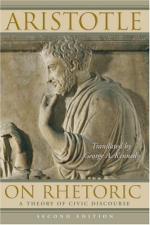
|
| Name: _________________________ | Period: ___________________ |
This test consists of 15 multiple choice questions and 5 short answer questions.
Multiple Choice Questions
1. According to Aristotle, what act should the political rhetorician be concerned with?
(a) The act of legislation.
(b) The act of limitation.
(c) The act of rejection.
(d) The act of ratification.
2. What was the difference between rhetoric and dialectic in the logical appeal?
(a) The methods used.
(b) The length of the speech.
(c) The timing of the argument.
(d) There was no difference between them.
3. Which one of the following was not listed by Aristotle as a form of happiness?
(a) Popularity.
(b) Virtue.
(c) Reputation.
(d) Honor.
4. What description of the ethical appeal was given by Aristotle?
(a) Appeal to the speaker's past.
(b) Appeal to the speaker's intent.
(c) Appeal to the speaker's associations.
(d) Appeal to the speaker's character.
5. Which of the following was a reason that Aristotle included as a cause of pity?
(a) Luck.
(b) Deserved punishment.
(c) Undeserved punishment.
(d) Laziness.
6. What was included in the special laws referenced by Aristotle?
(a) Some of the logical opinions of a political body.
(b) All of the logical opinions of a political body.
(c) Some of the explicit statutes of a political body.
(d) All of the explicit statutes of a political body.
7. As explained by Aristotle, what comprised good?
(a) Many different things.
(b) A few different things.
(c) Only two main things.
(d) Only one main thing.
8. As Aristotle explained, in which situations would rhetoric be useful?
(a) Situations where dialectic would be misunderstood.
(b) Situations where dialectic would be inappropriate.
(c) Situations where dialectic would also be appropriate.
(d) Situations where dialectic would be understood.
9. As explained in Book II, Chapter 4, what type of friends were people most likely to choose?
(a) Ones that associated with the same people as them.
(b) Ones that associated with people different from them.
(c) Ones that had a different social or economic status.
(d) Ones that had a similar social or economic status.
10. Of the two kinds of witnesses, why did Aristotle think the ancient witnesses were useful?
(a) They could be questioned or tampered with.
(b) They could be tampered with or accused of partiality.
(c) They could be questioned or accused of partiality.
(d) They could be questioned, tampered with, or accused of partiality.
11. Which cause of human action did Aristotle mention as always being unpleasant?
(a) Compulsion.
(b) Habit.
(c) Appetite.
(d) Anger.
12. According to Aristotle, what was the most basic cause of pleasure?
(a) Some kind of action in accordance with one's nature.
(b) Some kind of action in accordance with one's abilities.
(c) Some kind of action in accordance with one's desires.
(d) Some kind of action in accordance with one's instincts.
13. How did Aristotle define calmness?
(a) The opposite of excitement.
(b) The same as boredom.
(c) The same as normal.
(d) The opposite of anger.
14. From the information in Book II, Chapter 1, what should a speaker do in order to put the audience in a certain frame of mind?
(a) Ask them questions.
(b) Compliment them.
(c) Challenge them.
(d) Manipulate their emotions.
15. Why did Aristotle think the political rhetorician should show that their proposal was in line with the audience's happiness?
(a) To prevent them from forgetting it.
(b) To encourage them to consider it.
(c) To convince them to accept it.
(d) To help them understand it.
Short Answer Questions
1. When did Aristotle think "what is good" made one happy?
2. What did Aristotle think the extent of virtues was based on?
3. What did Aristotle think was the intent of all voluntary actions?
4. Which tactic was not included as something that an epideictic rhetorician might use?
5. Concerning the elicitation of the praise or blame of an audience, what was epideictic rhetoric also called by Aristotle?
|
This section contains 600 words (approx. 2 pages at 300 words per page) |

|




